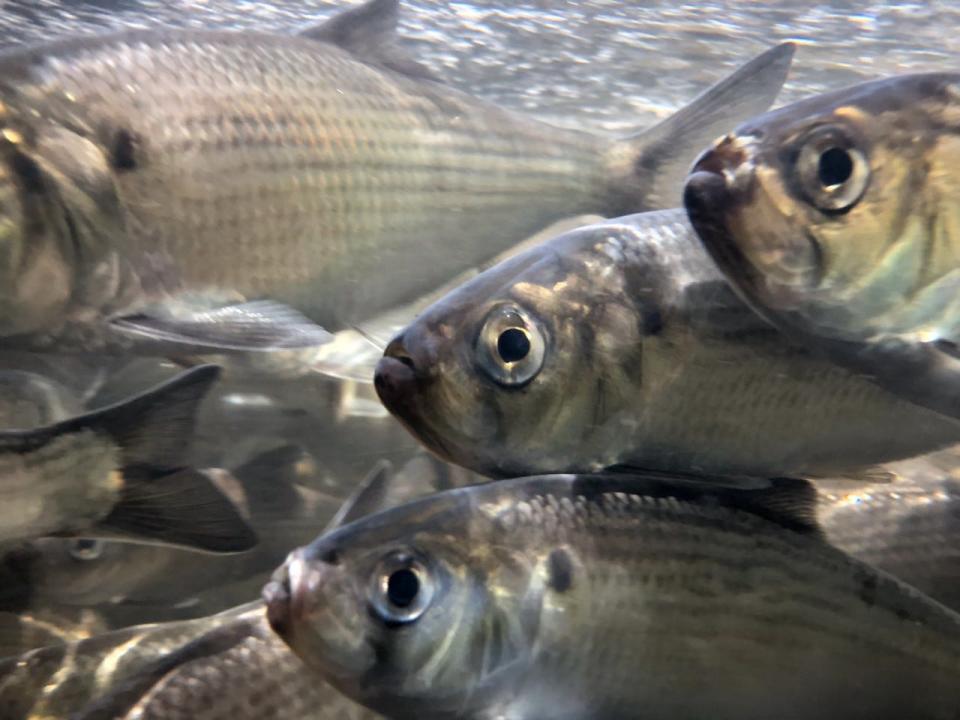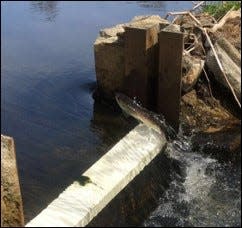Barnstable Clean Water Coalition needs help counting fish. Why, and what you can do.
Spring is just a few weeks away, and for the Barnstable Clean Water Coalition that means one thing in particular: It's time to count fish.
Not just any fish. River herring.
The organization is putting together a team of volunteer herring monitors at fish ladders along the Marstons Mills River for the annual spring migration of river herring. Counting takes place April 1 to June 1.
In order to prepare, the coalition is hosting an in-person information and training session on Wednesday, March 8 for anyone interested in volunteering their time to count the herring as they make their way upriver. The session will be held at 4:30 p.m. in the Osterville Village Library, 43 Wianno Ave.
Heather Rockwell, director of operations at the coalition, said the organization has coordinated the volunteer herring count monitoring program since 2014. There are two fish ladders, one at Mill Pond (Routes 149 and 28) and one at Middle Pond (Flume Avenue).

Why is it important to keep track of herring numbers?
River herring populations have declined over the last few decades as a result of overfishing, habitat degradation and other environmental factors, including climate change, according to Rockwell.
"The river herring count data is submitted to scientists at the Massachusetts Division of Marine Fisheries, who use this data to estimate the herring run size at each fish ladder," she said.
This, in turn, informs the agency about the status of river herring populations throughout the state, which guides management decisions and regulations that help sustain those populations on the coast.
The agency notes that river herring are "an important component of a healthy coastal and riverine ecosystem."
What does it take to be a herring monitor?
"It’s fun and easy" to be a herring monitor, said Rockwell.
Herring monitors are responsible for counting river herring and collecting associated observational data, such as weather and river conditions, for 10 minutes in any given hour from 7 a.m. to 7 p.m.
"Monitors count the herring as they cross up and over the fish ladders on their annual spring migration from Nantucket Sound through the Three Bays estuary up the Marstons Mills River into Middle Pond," she said.
There are more than 100 river herring runs throughout the state.
What are monitors taught during the training?
At the training and information session, herring monitors will learn about river herring and how to count and collect data. The Barnstable Department of Natural Resources will present an update on herring runs located in Barnstable.
The guest speaker at this year’s training is John Sheppard, diadromous fisheries biologist with the state's marine fisheries division, "who will discuss the importance of the visual count data collected by volunteers and how that is used to estimate the state’s herring run sizes," Rockwell said.
How many volunteers are needed?
When it comes to the number of volunteers needed for a successful herring count, Rockwell said, "the more, the merrier."
"The Barnstable Clean Water Coalition is responsible for covering hourly counts at the two fish ladders from 7 a.m. to 7 p.m. every day from April 1 through June 15," she said.
Ideally, the organization needs at least nine counts per day for two and a half months at each fish ladder, for a total of 18 volunteer counts per day for 76 days.
"That’s a lot of counts," said Rockwell, "and it takes a lot of volunteers."

Tell me more about river herring.
There are two species of fish in coastal Massachusetts collectively referred to as river herring, according to the Massachusetts Division of Marine Fisheries. They are alewife (alosa pseudoharengus) and blueback herring (alosa aestivalis)."
Millions of these fish migrate into state coastal waters each spring.
"They are returning to the place of their birth, to spawn and create a new generation of river herring," the Massachusetts Division of Marine Fisheries notes in its pamphlet "A Guide to Viewing River Herring in Massachusetts."
The fish "face many challenges along their spawning runs," the agency said, including dried-up river beds and predators like striped bass, bluefish, cormorants, and humans. Additionally, "dams and steep elevation changes completely block their passage in many streams."
The river herring are helped around these barriers by man-made fish ladders. According to the agency, fish "congregate and cue up for a chance to fight the current, rush up the ladders, and continue on with theirjourney. This behavior creates an amazing spectacle that attracts thousands of visitors each year."
For a list of herring runs and more viewing tips, visit https://www.mass.gov/doc/dmf-river-herring-guide/download
For more information about the Barnstable herring, or to become a volunteer, contact Heather Rockwell at hrockwell@bcleanwater.org
Contact Heather McCarron at hmccarron@capecodonline.com.
Gain access to premium Cape Cod Times content by subscribing. Check out our subscription offers.
This article originally appeared on Cape Cod Times: What to know about Barnstable's spring herring count, and how to help

